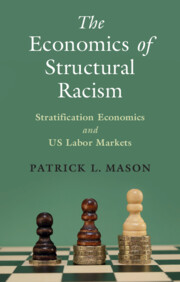Book contents
- The Economics of Structural Racism
- Cambridge Studies in Stratification Economics: Economics and Social Identity
- The Economics of Structural Racism
- Copyright page
- Dedication
- Contents
- Figures
- Tables
- Part I Foundations
- 1 Introduction
- 2 Racial Identity As an Economic Norm
- 3 Mechanisms of Stratification
- 4 Regimes of Racial Stratification
- Part II African American Educational Progress and Transformations in Family Structure, 1965–Present
- Part III African American Income and Wealth, 1965–Present
- Part IV Structural Racism, 1965–Present
- Part V Restatement and Discussion
- References
- Index
3 - Mechanisms of Stratification
Insecurities and Inequities of Capitalist Competition
from Part I - Foundations
Published online by Cambridge University Press: 06 April 2023
- The Economics of Structural Racism
- Cambridge Studies in Stratification Economics: Economics and Social Identity
- The Economics of Structural Racism
- Copyright page
- Dedication
- Contents
- Figures
- Tables
- Part I Foundations
- 1 Introduction
- 2 Racial Identity As an Economic Norm
- 3 Mechanisms of Stratification
- 4 Regimes of Racial Stratification
- Part II African American Educational Progress and Transformations in Family Structure, 1965–Present
- Part III African American Income and Wealth, 1965–Present
- Part IV Structural Racism, 1965–Present
- Part V Restatement and Discussion
- References
- Index
Summary
Structural racism arose with European exploration, enslavement and colonization of Africans, triangular trade, and the historical development of capitalism as a world system. Structural racism consists of public policies and institutional practices with persistently racially disparate outcomes, cultural representations that continuously encourage invidious comparisons across racial groups, and norms of social interactions that encourage the reproduction of racialized social identities. Structural racism then is distinct from personal racial prejudice, that is, racially biased decisions, and from personal racial bigotry, that is, racially hostile actions or values based on irrational opposition towards those perceived as different. Structural racism allows “privileges associated with ‘Whiteness’ and disadvantages associated with ‘color’ to endure and adapt over time. … (Aspen Institute, 2004).” In addition to the formation of racial identity as a social norm, wealth inequality, involuntary unemployment, and the exploitation of labor are economic mechanisms that create the conditions for permanent structural racism. Racial differences in wealth, initially created by chattel and servitude capitalisms, reproduce racial disparities in economic, political, and social outcomes. These disparities embed a disproportionately large fraction of Whites in positions of power and authority within hiring institutions.
Keywords
- Type
- Chapter
- Information
- The Economics of Structural RacismStratification Economics and US Labor Markets, pp. 39 - 59Publisher: Cambridge University PressPrint publication year: 2023

